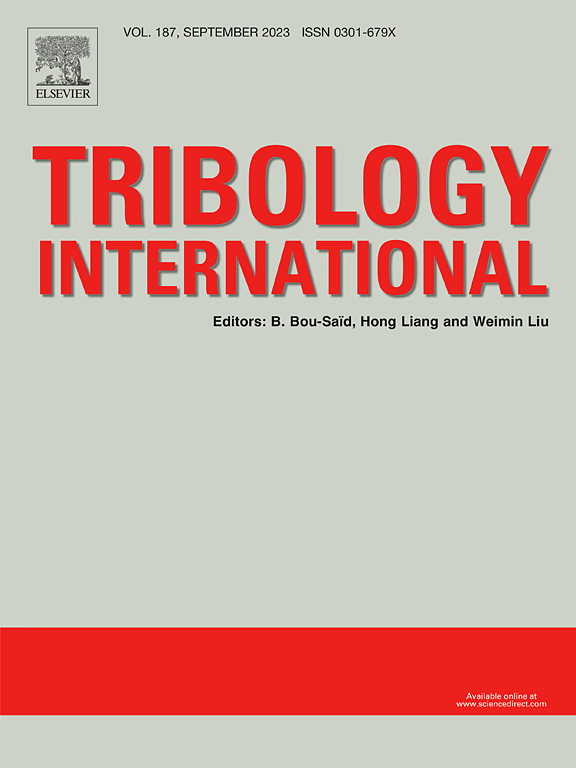Microstructure, mechanical and tribological characterization of magnetron sputtering ZrN and ZrAlN coatings
IF 6.1
1区 工程技术
Q1 ENGINEERING, MECHANICAL
引用次数: 0
Abstract
In this research paper, mechanical and tribological characterization of novel high wear-resistant ZrN-ZrAlN coatings are presented. The varying concentrations of AlN is chosen to evaluate the influence of AlN the surface morphological, nanomechanical, and tribological properties of the composite coating. The coatings were developed on D9 steel substrates using nitrogen reactive gas radio frequency (RF) magnetron sputtering of zirconium and aluminium targets in an argon plasma. Variable power density for the aluminium target and constant power density for zirconium, was used to obtain in a systematic way, the variable concentration of AlN in the coating. Surface morphological studies were carried out to evaluate composition and crystal structure using X-ray diffraction (GIXRD), Raman spectroscopy, and energy-dispersive X-ray spectroscopy (EDS). Coatings display a polycrystalline structure, but the level of crystallinity decreases with higher AlN concentration. Nanomechanical and nano scratch testing, along with tribological experimental studies were performed to comprehensively analyse performance of the developed coatings. Higher hardness of composite coating is achieved with optimal concentration of AlN in ZrN-ZrAlN coating. Adhesion strength of the coatings increased with the increase in the concentration of AlN. ZrN-ZrAlN coatings depicted low wear, however coatings containing AlN exhibits superior wear resistance.
磁控溅射 ZrN 和 ZrAlN 涂层的微观结构、机械和摩擦学特性分析
本研究论文介绍了新型高耐磨 ZrN-ZrAlN 涂层的机械和摩擦学特性。选择不同浓度的 AlN 是为了评估 AlN 对复合涂层表面形态、纳米力学和摩擦学性能的影响。涂层是在氩等离子体中使用氮反应气体射频(RF)磁控溅射锆和铝靶材在 D9 钢基材上形成的。铝靶采用可变功率密度,锆靶采用恒定功率密度,从而系统地获得了涂层中不同浓度的氮化铝。通过 X 射线衍射 (GIXRD)、拉曼光谱和能量色散 X 射线光谱 (EDS) 进行了表面形态研究,以评估成分和晶体结构。涂层显示出多晶结构,但结晶度随着 AlN 浓度的增加而降低。为了全面分析所开发涂层的性能,还进行了纳米机械和纳米划痕测试以及摩擦学实验研究。ZrN-ZrAlN 涂层中 AlN 的浓度达到最佳时,复合涂层的硬度较高。涂层的附着强度随着 AlN 浓度的增加而提高。ZrN-ZrAlN 涂层的磨损率较低,而含有 AlN 的涂层则表现出更高的耐磨性。
本文章由计算机程序翻译,如有差异,请以英文原文为准。
求助全文
约1分钟内获得全文
求助全文
来源期刊

Tribology International
工程技术-工程:机械
CiteScore
10.10
自引率
16.10%
发文量
627
审稿时长
35 days
期刊介绍:
Tribology is the science of rubbing surfaces and contributes to every facet of our everyday life, from live cell friction to engine lubrication and seismology. As such tribology is truly multidisciplinary and this extraordinary breadth of scientific interest is reflected in the scope of Tribology International.
Tribology International seeks to publish original research papers of the highest scientific quality to provide an archival resource for scientists from all backgrounds. Written contributions are invited reporting experimental and modelling studies both in established areas of tribology and emerging fields. Scientific topics include the physics or chemistry of tribo-surfaces, bio-tribology, surface engineering and materials, contact mechanics, nano-tribology, lubricants and hydrodynamic lubrication.
 求助内容:
求助内容: 应助结果提醒方式:
应助结果提醒方式:


